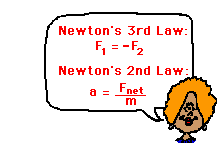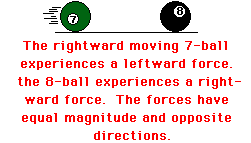Newton's Third Law of Motion states...
"...in every interaction, there is a pair of forces acting on the two interacting objects. The size of the force on the first object equals the size of the force on the second object. The direction of the force on the first object is opposite to the direction of the force on the second object. Forces always come in pairs - equal and opposite action-reaction force pairs."
Basically, what this says is that in any collision, the force of one object equals that of the force on the other, and that the force always comes in pairs- equal in the magnitude of the force and opposite in direction. These forces cause one object to speed up, gaining momentum from the other object, and the other object slow down, losing momentum due to the collision. The magnitude of force in the collision is equal between the two objects; however, the acceleration is necessarily not. In accordance to Newton's Second Law of Motion, the acceleration of an object is dependent upon both force and mass. What this means is that if the two colliding objects have different masses, the acceleration of the two objects will be different, even though the magnitude of the force will be equal.
Newton's Second and Third Laws of Motion can be represented by the following equations. In accordance with the game of billiards, imagine the collision of a moving cue ball with the eight ball at rest. When the cue ball collides with the eightball, each ball experiences the same amount of force in opposite directions. The cue ball, moving rightward, experiences a leftward force when colliding with the eightball, causing it to slow down. The resting eightball experiences a rightward force, causing it to move and accelerate. Because of the two balls having equal mass, they will have equal acceleration.
In Newton's 3rd Law, the F1 represents the first object's force, and the F2 represents the second object's force. The negative in the equation shows the opposite direction.
In Newton's 2nd Law, the acceleration of an object, represented by "a", is equal to the net force acted upon the object, "Fnet", divided by the mass of the object, "m". The formula is this way because the mass of an object varies inversely to the acceleration- as the mass goes up, the acceleration goes down.

HOME